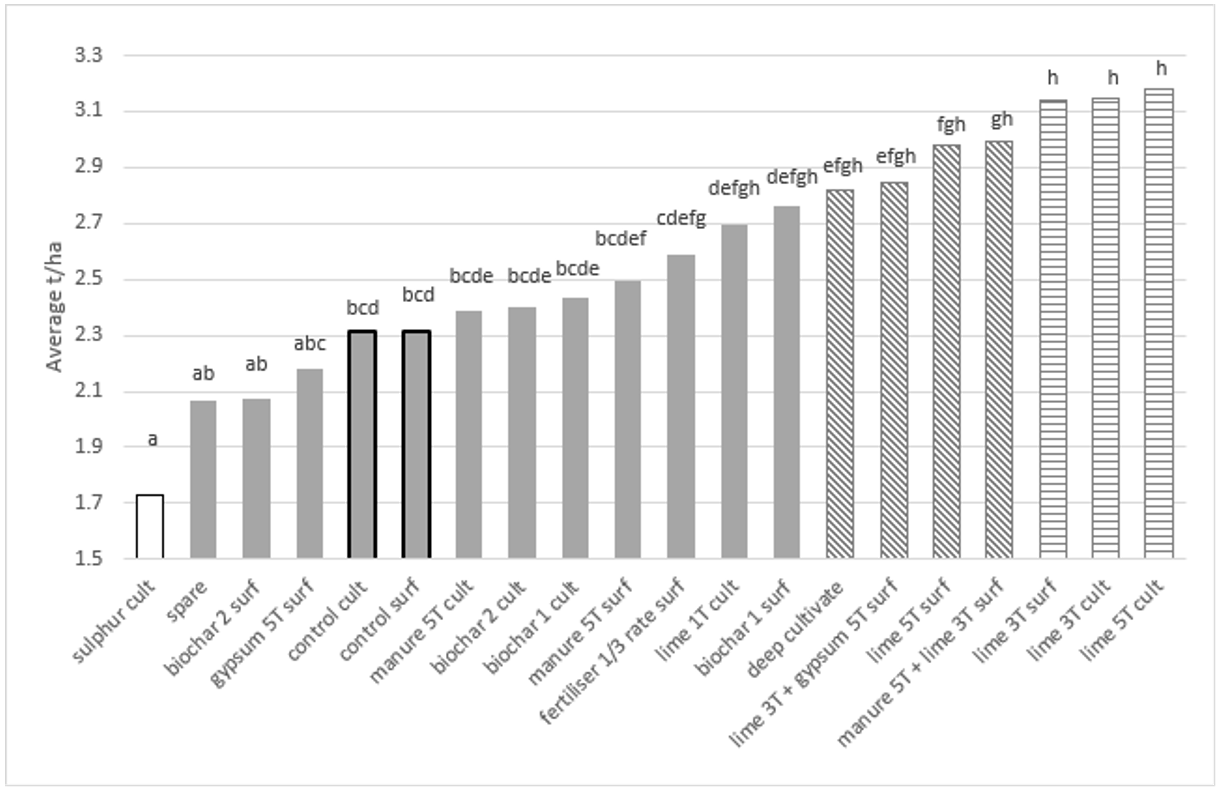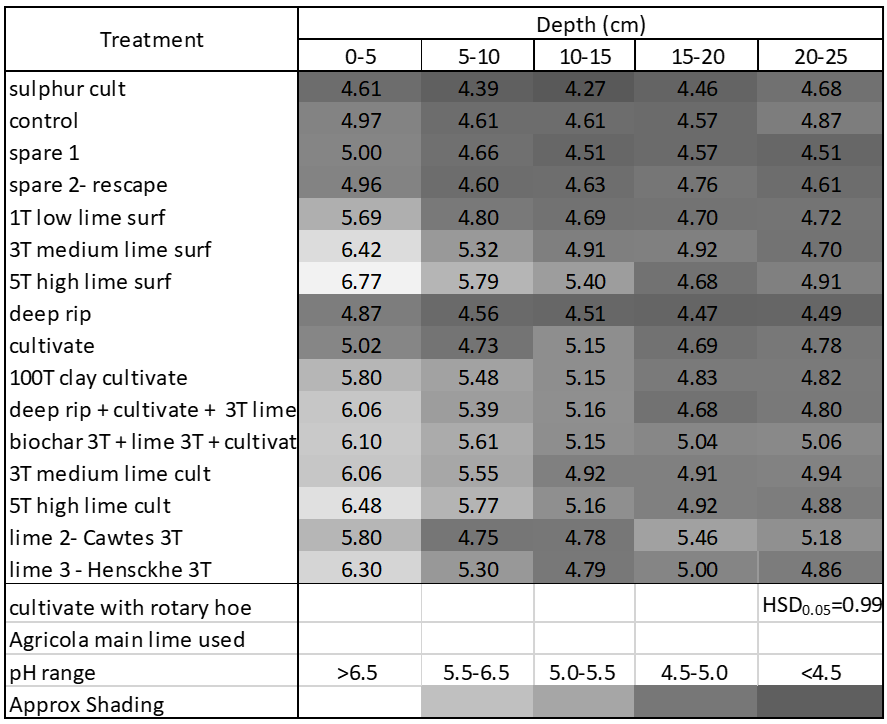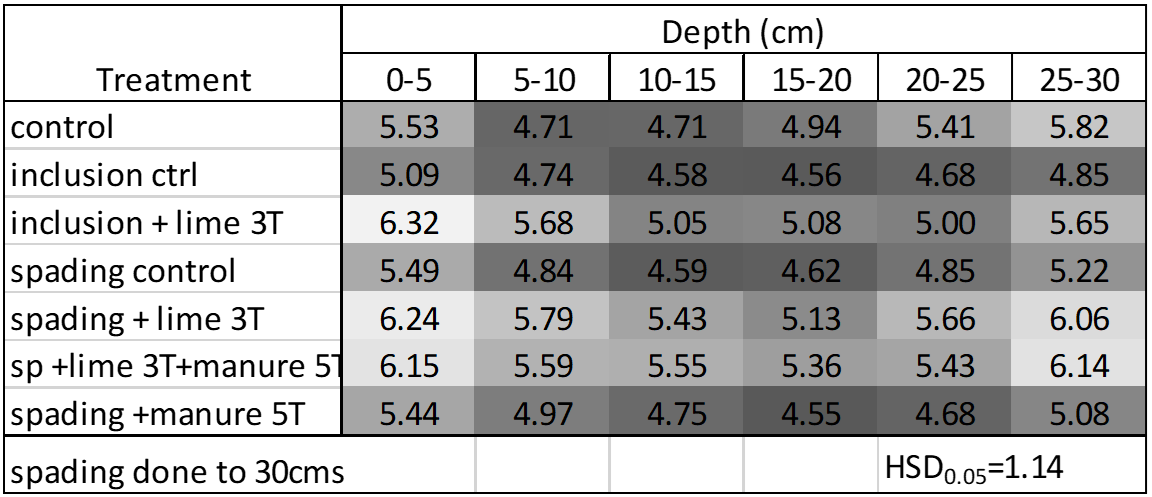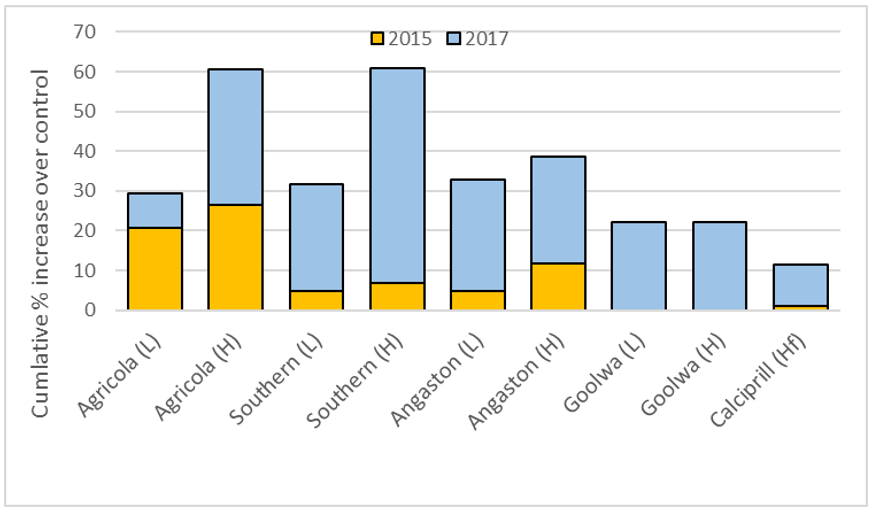Messages emerging from long term lime trials to combat soil acidity
Author: Brian Hughes, Andrew Harding, Nigel Fleming and David Woodard (SARDI and University of Adelaide) | Date: 06 Feb 2024
Take home messages
- Long-term trials sites tracking the effectiveness of liming across a range of cropping and soil types are providing detailed information on the effects on crop yields, lime movement, lime rates and pH changes.
- The effectiveness of incorporation of lime depends on the soil depth to the acidic layer and the type and effectiveness of incorporation and resulting mixing impact.
- Soil monitoring has provided a higher level of information on pH change and the impact of liming treatments than measuring grain yield alone.
- Differences in lime quality, outside of large differences in neutralising value and lime fineness have resulted in small or no differences in yield over time.
- Consistent impacts occur on plant trace element levels when liming including increased molybdenum and decreased manganese. Decreased copper for livestock is potentially an issue at some sites.
Background
Soil acidity is increasing across the dryland cropping area of South Australia (SA) due to more intensive and productive farming practices. It is estimated around 3 million hectares are now at pH levels where acidity may be an issue and this is expected to increase to 4 million hectares in SA over the next few decades.
Dual soil acidity projects were undertaken in Victoria (Vic, via Southern Farming Systems) and across South Australia in seasons 2019 to 2021. These included the establishment of new long term field trials, training of PhD students and a strong extension focus with the establishment of the SA Acid Soils website. A combined project across the Southern Region commenced in 2022 and will continue until 2025. This project is evaluating 20 sites including several new demonstration sites, supporting a post-doctoral study on the impact of liming on greenhouse gas emissions and delivering a strong extension program on findings.
This paper will focus on crop yield responses to lime, incorporation impacts, differences observed between liming products, trace element impacts and economics of liming at some sites.
Method
During 2023, nineteen existing and one new lime trial were monitored for dry matter and grain yield, with most sites having plant nutrient analysis completed as well. Several sites had detailed pH analyses during Autumn 2023. Seven sites were located in Vic and the rest across SA. Most sites have been established since 2019, although there are three sites older than this, with Westmere established in 2014. This paper is focussed on results from SA sites, with replicated design. Seven of these sites were sown and managed by the South Australian Research and Development Institute (SARDI) Agronomy team or Trengove Consulting and associates. In contrast, other sites were sown and monitored in paddock by growers. Sites were mostly chosen from acid areas identified through Veris pH mapping. Treatments varied within the local district and included liming products as well as manures at three sites, biochar, clay, gypsum and granulated lime treatments. At most sites, a sulphur treatment (known to reduce soil pH) was included to demonstrate where the yield would drop to if liming was not undertaken in the next few years.
Results and discussion
Lime responses
The largest positive yield responses to lime application have been observed with lentils, vetch and beans, however, smaller responses occurred in barley and acid-sensitive wheat varieties. No lime responses were observed in acid-tolerant wheat varieties, lupins or oats, although deep ripping, spading and clay have had impacts on these crop types. No response has been observed in canola from the two trials monitored, however, in both cases, the sites were not in very acid-responsive situations. In the year of application of lime, little or no response to lime was observed and, as a generalisation, lime responses increase in significance the longer they persist.
A range of lime response curves have been developed and crops can be assessed against treatments, pH of different layers or, in some cases, aluminium (Al) levels. Response curves varied significantly between crop type and site. Examples are shown with lime responses against treatments at Mallala in 2022 in Figure 1, responses against pH (0–5cm) in Figure 2a, and Al versus pH relationships highlighting differences between sites in Figure 2b.

Figure 1. Lime response in lentils at Mallala in 2022. P value <0.001 and Lsd at 5% of 0.49t/ha. Shaded groups are based on multiple comparison.

Figure 2.a – Lime response by pH level, Sandilands, 2023. Figure 2.b – Al vs pH(CaCl2) relationship at four sites.
Impacts of incorporation
A key requirement when assessing the possible impact of lime incorporation is understanding the soil pH profile. Four categories of acidification have been described and trial sites are attributed to categories as follows:
- Surface acidification – 0–10cm acid, often clay layer at 10cm (Mallala, Brooker)
- Deeper acidification – 0-15 to 20 cm acid (Sandilands, Spalding, Tungkillo)
- Stratified acidification/subsurface acid – 0–5cm slightly acid/ neutral, 5–15cm acid, (Kapunda, Koonunga- post liming), sandy 5–25cm acid (Lameroo, Yumali- not limed)
- Subsoil acidification – A horizon slightly acid/ neutral, B horizon acid – not normally an issue in cropping soils.
Understanding the type and depth of incorporation and the effectiveness of mixing helps to determine whether lime incorporation is justified. Several methods have been used in selected trials described below:
Tyned cultivator – at Sandilands, Koonunga and Kapunda
- At Sandilands, yield of incorporated lime treatments was significantly better than surface applied treatments in year 2 in 2020 in lentils but not since. Soil pH data in 2023 suggested plots with the incorporated treatments have a slightly improved subsurface pH compared with surface applied treatments.
- At Koonunga, yield of incorporated lime treatments was better than surface applied treatments in year 3 in 2021 under beans but not in other years. Other deeper treatments, such as mouldboard and granulated lime to depth, were much better than tyned incorporated in 2021, 2022 and 2023.
Offset disc to 7.5cm – at Mallala
- No significant difference was observed (slight trend only) in 2020 while in 2022 when in lentils and had significant responses to lime but no significance due to cultivation.
Rotary hoe – at Spalding, Yumali, Lameroo and Wirrabara
- Provided a good mix to 10cm, cultivation impacts at Yumali still significantly better than surface applied lime after four seasons.
Mouldboard plough – at Koonunga
- Koonunga had lime application prior to the trial but acidity down to 25cm. Mouldboard ploughing has been significantly better than surface applied lime or tyned incorporation over last three years when the trial has responded. The impact of the different incorporation treatments at this site is shown in Figure 3 and highlights the positive impact of the mouldboard plough and subsoil Calciprill a granulated lime in increasing the pH around 5–15cm.

Figure 3. Impact of treatments on pH of profile at Koonunga.
Deep ripping
- Deep ripping has been undertaken at several sites. At the silicious sand sites at Yumali, Bute and Lameroo, deep ripping alone gave a response, while at the sandy loam sites at Sandilands and Mallala, deep ripping gave nil to small responses. Where lime was added prior to deep ripping, responses were much more significant than deep ripping alone compared to controls.
Sandy soil modification
- The use of spading and inclusion plates with and without lime was tested at two sites and provided significant response from the treatment without liming. At Lameroo in year 3, the lime with spading seemed to be having an additional impact on dry matter.
- The use of clay at Yumali had been the highest yielding treatment overall (significant responses in years 3 and 4). This treatment increased soil pH, as well as overcame other sand issues such as high-water repellency and low CEC.
- The impact of different treatments on pH by layer is shown in Tables 1 and 2, which highlight that little pH change occurs without adding lime when ripping, spading or using inclusion plates where no clay was added.
Table 1: Impact on the pH profile from a range of treatments at Yumali (sand over clay), 2023.

Table 2: Impact on the pH profile from a range of soil modification treatments at Lameroo, 2023.

Comparing limes
At several sites, locally available lime products were compared for various parameters. Two approaches were taken: some trials compared products as is and other trials compared products after their neutralising values were adjusted to 100%. Comparisons were made of yield, NDVI, plant and soil tests on several trials.
Impacts on yield
Historically, the largest differences in grain yield were observed in the Tungkillo trial, where higher rates of Agricola and Southern limes gave around 60% more grain yield over 4 years after lime application compared with 25–40% for the much coarser products. Application of Agricola lime led to a significantly better yield increase in year 2 (see Figure 4).

Figure 4. Cumulative grain yield (%) increase by lime treatment compared to the control at Tungkillo Trial Site between 2015 and 2017. ( H – high rate 6T/ha, L- low rate 3 T/ha)
At Wirrabara, where products were adjusted for NV, the Clare quarry lime gave a slightly better cumulative yield over time, with an extra 1–2t/ha grown over a 9-year period, in comparison with coarser products including Kulpara, old Angaston and Nutrilime. This was evident in year 2 in barley, when the finer product gave the best yield.
At Sandilands, no yield differences have been observed from dolomites versus limes. At Yumali, some differences were observed, which can, in part, be attributed to the lower NV of the Cawtes product, where all products were applied at 3t/ha.
Impacts on soil and plant indicators
At Sandilands, the differences in the observed soil cations showed the impact of dolomites versus lime. In Figure 5a and 5b, levels of 0–10cm soil exchangeable calcium and magnesium are presented for Sandilands, 5 years after surface application at 4t/ha, with dolomites highlighted.

Figure 5. a – Soil calcium (mg/kg) Sandilands 2023. Figure 5. b – Soil magnesium (per cent) Sandilands 2023.
Plant indicators for the same group of tests indicated that there were only slight effects on plant magnesium (Mg) and calcium (Ca) by the dolomites versus lime, with both levels for all treatments within the adequate range for Ca and Mg (see Table 3).
Table 3: Plant tests for Sandilands, wheat Youngest Emerged Blades (YEBs) with P values.

Impact on trace elements – Mo, Mn, Cu
Impacts on trace elements are far more significant by the lime vs control treatments vs sulphur plots. Lime treatments significantly increased molybdenum (Mo) at all sites and across all crops and, in many of the legumes, Mo levels were at critically low levels (see Table 3).
At all sites, manganese (Mn) was reduced by liming rates and other treatments which impact on pH, for example, claying. In most cases, the reduced level of manganese was still well above the critical level. However, low Mn has been reported as an issue in isolated crops and pastures, particularly lupins and sub-clover after liming, suggesting a need to apply Mn as a foliar treatment to these at-risk plants often linked to sandier soils, and/or to avoid excessively high rates of lime at such sites.
A third trace element under consideration is copper, particularly linked to livestock health which have higher requirements above what is required in plants. Where Mo is increased, there is the potential for copper deficiency through a Cu:Mo interaction. In most cases, the liming treatments were not decreasing copper in the plant (see Table 3), however they are increasing molybdenum. Avoid applying extra Mo as a fertiliser when liming, as availability of existing Mo will increase substantially with the pH change from liming.
Economics of liming
The economics of liming and other treatments has been assessed for two sites at Yumali and Sandilands. For Yumali, when taking into account costs and returns of treatments, the best three treatments are medium lime 3t/ha cultivated, clay cultivated @100t/ha and deep rip/cultivate and lime 3t/ha, returning an extra $700–900/ha (up to 3t grain). At Sandilands, the best five treatments are Angaston 4t/ha + rip, Kulpara 4t/ha surface, Agricola 4t/ha surface, Angaston 4t/ha + gypsum @5t/ha and Angaston 6t/ha surface, each returning around $300/ha; tilled treatments are behind these. No account has been made of residual amounts of lime applied, as 4t/ha at Sandilands will possibly account for acidification produced over a 15-year period.
Acknowledgements
The research undertaken as part of this project is made possible by the significant contributions of growers through both trial cooperation and the support of the GRDC, the authors would like to thank them for their continued support. The providers of products are also recognised.
The authors also acknowledge SARDI, DEW, Murraylands and Riverland landscape Board, Hills and Fleurieu Landscape Board for their contributions. SAGIT is also acknowledged as a project funder examining critical Al and Mn levels. Also acknowledged are L. Simpson and Dr N. Wilhelm for their work establishing and managing trials on this project and other project team members including from the University of Adelaide, Southern Farming Systems, Trengove and Associates, Ag Communicators and SARDI EP and other staff.
Useful resources
GRDC Acid Soils Southern Region
Contact details
Brian Hughes
SARDI
Nuriootpa Research Centre
Box 245, Nuriootpa SA 5355
0429 291 468
brian.hughes@sa.gov.au
GRDC Project Code: UOA2206-009RTX,
Was this page helpful?
YOUR FEEDBACK
